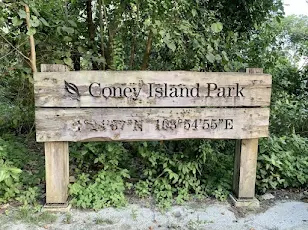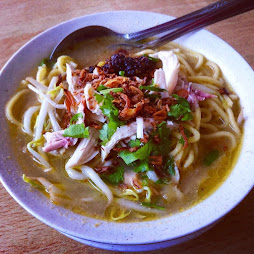Anyone who has visited Coney Island before, will certainly have been awestruck by the tall and lush
casuarina trees, probably the largest clusters of casuarina trees in one place one has seen in Singapore. There are casuarina trees almost everywhere on the island. Also known as the
Common Rhu, Rhu being the Malay word for casuarina, there are casuarina trees elsewhere in Singapore too, like at the
Big Sisters Island in the southern islands, but not in the same scale as at Coney Island Park.
Located off the northeastern coast of Singapore, between
Pulau Ubin to its northeast and the mainland to its southwest, Coney Island is the starting or the ending point of the 36km (22 miles) coast to coast trail, depending on if you start from there or from
Jurong Lake Gardens. Connected to
Punggol Point and Punggol Promenade by a bridge on the west entrance, the 87-hectare Coney Island fronts the new Punggol Town and provides respite to the residents there. Actually, there are several parks around Punggol area including the
Punggol Waterway Park and
Sengkang Riverside Park, and they are all connected by the park connector network (PCN), all these three parks part of the coast-to-coast trail.
 |
| Rustic-looking Coney Island Park signboard |
Coney Island is known by several names, including '
Serangoon Island' or 'Pulau Serangoon'. Pulau is a Malay word for island. In the 1930s to 1950s, it was also known as 'Haw Par Island' because it was owned by the
Haw Par brothers. It has been uninhabited for decades, but was once a popular spot for family picnics, and activities such as water-skiing, boating and fishing.
Kelongs (fishing platforms) also once dotted the waters off the island.
On 7th October 1936 - The Haw Par brothers, Aw Boon Haw and Aw Boon Par, bought the island. On 4th April 1950, Indian businessman, Ghulam Mahmood, took over the island and planned to turn it into a resort. He renamed the island after the Coney Island amusement park in New York. However, the plan was never realised. So, when you to go to google map and put in 'Coney Island', it shows the one in New York. For Singapore, it is sometimes still annotated as Serangoon Island.
 |
| Sunset at Coney Island among casuarinas |
In 1972, Port of Singapore Authority purchased the island to develop for recreational purposes. In 1987, it was announced that the northern islands would be developed for recreation with Coney Island as part of the upcoming Punggol New Town project. By then the two link bridges were built which were great for ease of access. It was opened to the public as a nature park in 2015, after undergoing extensive restoration and conservation efforts to protect its unique ecology.
The island is rich in history and biodiversity and is highly valued by nature lovers. The 133 hectares Coney Island Park is home to at least 157 fauna species and around 86 tree species, of which 53 fauna and 17 tree species are considered locally threatened. So other than casuarina trees, other flora to spot include
Borneo Mahogany and Mangroves Trumpet trees.
Approximately 80 bird species can be sighted on the island. With its rich biodiversity, Coney Island Park is a fitting location for bird and nature enthusiasts. The birds that you might be able to spot include white-bellied eagle, green heron, white-throated kingfisher, munia, crake and pacific swallow. White bellied eagle is quite common sighting elsewhere in Singapore too such as at Pulau Ubin and the
Southern Islands. Herons are abundant at
Pasir Ris and
Sungei Buloh. Kingfishers can be spotted at practically all parks, though they can be quite elusive and fast. There are bird hides on the island. If you are fortunate, you may spot the rare and endangered species like the
Grey-headed Fish Eagle and the Buffy Fish Owl
Intertidal walking is gaining traction here, especially during the pandemic with border closures people are finding nature walks as an outlet to being stuck at home. Some marine creatures that you may spot at the beach such as crabs, shrimps, seagrass, snails, whacks and sea cucumber. But of course, it would be great if you do not trample or take away any marine creatures that you see. Just admire from above so that others can admire them too.
There is Go Cycling bike rental station where you can cycle inside Coney Island or to Sengkang Riverside Park or Punggol Waterway Park which are all connected by the PCN. You can return the bike at the next park or do a merry go round and enjoy the scenic coastal views both ways. You can also walk between these parks which are part of the Coast-to-Coast trail. Coney Island is checkpoint number 9 on the coast-to-coast trial app.
 |
| Punggol Point Jetty at sunset |
There are two entrances to Coney Island, east and west entrances, via the causeways or bridges which bound the Serangoon Reservoir and act like dams. Both entrances are gated. As it is a protected area, the park closes from 7pm to 7am daily. The easiest way to the island is via the West Entrance which is near Punggol Jetty at Punggol Point. Punggol Point is better connected by public transport such as LRT. Closest LRT is Punggol LRT. East entrance is via Lorong Halus. There are signages to show you the way around outside and within the island.
You can walk the whole length of the island from west to east or vice-versa, but for many the other than the casuarina trees, the beach on the north is also a must see. Outside Coney Island, at Punggol Point, near Punggol jetty, is a sandy beach that is quite amazing. Well, the whole Punggol Beach fronting Johor Strait is indeed pretty cool place to chill. However, Punggol Point has a
dark history where during World War II, the Sook Ching Massacre took place, similar to the gory event that happened at
Changi Beach. There is a signage at Punggol Jetty chronicling the darkest days in Singapore.
 |
| Cycling to Coney Island |
The Serangoon Reservoir, one of the 17 freshwater reservoirs in Singapore, is bounded in-between both east and west entrances at the sides, Coney Island to the north and Punggol Promenade to the south. It's called Serangoon Reservoir as we have learned Coney Island is also known as Serangoon Island, thus the name of the reservoir.
You will have a better view of the reservoir near the east entrance. Outward Bound School is now under construction near the east entrance but hopefully they will not take up too much forest space. There is another reservoir nearby, Punggol Reservoir at Punggol Waterway Park.
There is 7-11 convenience store and several restaurants, mainly serving seafood, at Punggol Point. There is a vending machine selling drinks near the washroom next to the
turtle pond. Look closely at the murky pond and there are many turtles inside there. Do you know that there is place in Singapore called Tanjong Rhu, literally meaning Casuarina Cape, is named after the Common Rhu? Tanjong Rhu is located along Geylang River. You can see some casuarina trees near the area. Just like at Coney Island, casuarina trees or pokok Rhu in Malay, thrive well near the sandy shores or beaches.








Comments
Post a Comment